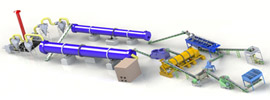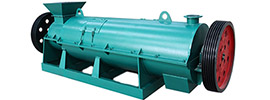A trough turning machine is a mechanical device widely used in organic waste treatment, renowned for its efficient and controlled composting operations that significantly enhance fermentation efficiency and product quality. Below is a detailed analysis of its core advantages and typical application scenarios.
I. Core Advantages of Trough Turning Machines
- High Efficiency, Saving Time and Labor
- High Automation: Driven by electric motors, the turning shaft rotates while the traveling mechanism enables autonomous pile-turning, minimizing manual intervention. Daily processing capacities range from hundreds to thousands of cubic meters, far exceeding manual methods.
- Continuous Operation: Capable of 24/7 uninterrupted work, it shortens the composting cycle from traditional 3–6 months to 15–30 days.
- Uniform Turning, Enhancing Compost Quality
- Adjustable Depth and Width: The turning shaft operates at customizable depths (typically 0.8–1.5 m) and spans the entire fermentation trough width, ensuring thorough material mixing and preventing localized anaerobic conditions or overheating.
- Promoting Aerobic Fermentation: Increased air contact through turning accelerates microbial decomposition, improving organic matter conversion rates while reducing odors and harmful gas emissions.
- Compact Structure, Space-Efficient
- Longitudinal Trough Design: Materials are stacked longitudinally within the trough, with the machine moving laterally along rails. This layout is ideal for land-constrained sites (e.g., urban peripheries or factory interiors).
- Modular Scalability: Production capacity can be adjusted by extending trough length or adding units to meet varying processing demands.
- Versatile Material Adaptability
- Multi-Type Feedstock Compatibility: Handles livestock manure, crop straw, sewage sludge, food waste, and other organic residues, even high-moisture materials (after pre-treatment for water adjustment).
- Corrosion Resistance: Critical components (e.g., turning shafts, blades) are made of stainless steel or coated with anti-corrosive materials to extend service life.
- Environmentally Friendly and Energy-Efficient
- Reduced Secondary Pollution: Enclosed trough designs control odor dispersion, while integrated deodorization systems further mitigate environmental impact.
- Resource Recycling: Converts waste into organic fertilizer, reducing chemical fertilizer use and promoting agricultural ecological cycles.
II. Typical Application Scenarios
- Large-Scale Organic Fertilizer Production Enterprises
- Mass Production Needs: Processes vast quantities of livestock manure (e.g., from pig or poultry farms) or crop residues via continuous turning for efficient fermentation.
- Standardized Production Lines: Integrates with automated batching and granulation systems to form complete organic fertilizer manufacturing workflows.
- Agricultural Cooperatives and Planting Bases
- Self-Sufficient Models: Combines locally generated crop straw with livestock waste to produce organic fertilizer for in-house farmland, lowering fertilizer costs.
- Demonstration Projects: Serves as a benchmark for eco-agriculture, showcasing waste-to-resource technologies.
- Municipal Sludge Treatment Projects
- Sludge Reduction and Resource Recovery: Ferments sewage sludge from wastewater treatment plants with conditioning agents to produce landscaping fertilizer or soil amendments.
- Regulatory Compliance: Meets environmental standards for sludge disposal requiring "reduction, harmlessness, and resource recovery."
- Food Waste Processing Plants
- Post-Pretreatment Fermentation: After sorting and shredding, food waste is mixed with bulking agents and subjected to aerobic composting via trough turning for accelerated maturation.
- Odor Control: Enclosed troughs paired with biofilters effectively minimize processing odors.
- Industrial Organic Waste Treatment
- Food Processing Byproducts: Converts residues like brewer’s grains or sugar beet pulp into animal feed or fertilizer through fermentation.
- Pharmaceutical Waste Sterilization: Treats organic residues requiring pathogen inactivation via high-temperature composting.
III. Selection Guidelines
- Capacity Matching: Choose trough width (typically 2–6 m) and motor power (15–75 kW) based on daily processing volume.
- Material Characteristics: Opt for reinforced blade designs for viscous or fibrous materials to prevent clogging.
- Site Constraints: Ensure trough length aligns with the machine’s travel range and reserve space for maintenance.
Trough turning machines address inefficiencies and quality inconsistencies in traditional composting through mechanization and automation, making them indispensable for modern organic waste resource recovery. Their applications span agriculture, municipal services, and industry, supporting circular economy and sustainable development goals.
This translation preserves technical precision while ensuring readability for an English-speaking audience in the environmental engineering and agricultural sectors.
 Send us a Email
Send us a Email Wulong Industrial Cluster
Wulong Industrial Cluster Have any question?
Have any question?



















